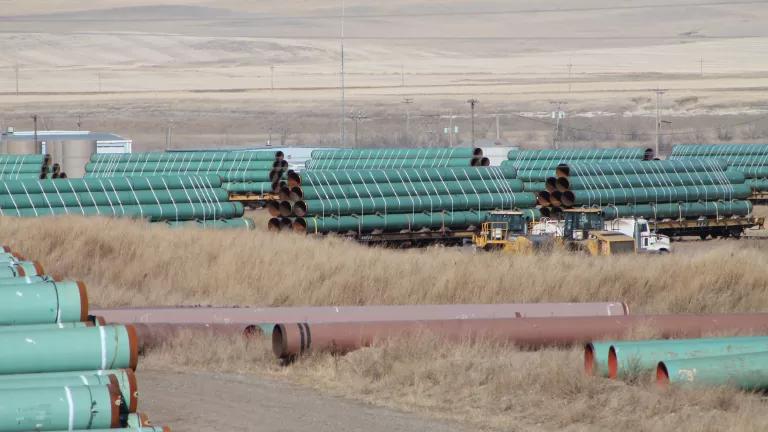Federal Court Halts Trump Attempt to Fast-track Keystone XL

A federal court in Montana has revoked a key permit and TC Energy’s approvals to construct Keystone XL through approximately 700 water crossings in the United States along the tar sands pipeline’s route.
A U.S. District Court in Montana delivered a significant blow to the Keystone XL tar sands pipeline in a landmark decision effectively revoking a key permit allowing the pipeline to cross over approximately 700 waterways. TC Energy had planned to cross those waters using a permit issued by the U.S. Army Corps of Engineers, Nationwide Permit (NWP) 12, which provides a streamlined and opaque approval process. In a victory for NRDC and its partners—Bold Alliance, Sierra Club, Center for Biological Diversity, and Northern Plains Resource Council—the court vacated NWP 12, finding that the Corps had violated the Endangered Species Act (ESA) in issuing the general permit. This decision adds to the legal obstacles facing Keystone XL and stymies TC Energy’s plans to construct the controversial tar sands pipeline just weeks after the government of Alberta attempted to push the project through with a public investment of $1.5 billion.
What is Clean Water Act (CWA) Nationwide Permit (NWP) 12?
NWP 12 is a five-year general permit intended to be issued for specific categories of activities that have minimal direct or cumulative environmental impacts. The general permit allows projects that will discharge dredged or fill material into U.S. wetlands or waterways to move forward without undergoing the comprehensive and transparent environmental review ordinarily required by the CWA, and often without any notification to or further action by the Corps. While the NWP 12 process was intended to fast track CWA approvals for certain categories of projects that truly have minimal environmental impacts, in recent years the Corps has used the project to avoid environmental review for large-scale pipeline projects like Keystone XL.
In 2017, the Corps reissued NWP 12—a permit that the Corps estimated would be used to fast-track nearly 60,000 projects in a five-year period, including major pipeline projects like Keystone XL. Despite the significant footprint of many of these projects which both agencies and groups like NRDC pointed out in extensive public comments, the Corps determined the cumulative impact of these fast track approvals would have no significant impact on the environment or endangered species.
What did the federal court decide?
The court ruled that the Corps acted in an arbitrary and capricious manner when it determined that NWP 12 was certain to have no impact on endangered species or their habitat. The ESA requires the Corps to conduct a programmatic consultation with Fish and Wildlife Service (FWS) experts if there is even a possibility that NWP 12 and the projects it fast tracks would have an impact on endangered species.
The Corps’ decision that there would be no such impact was undercut both by expert declarations filed by NRDC and its partners showing that Keystone XL would have an impact on listed species and by the fact that the Corps had previously recognized that NWP 12 would impact endangered species. Finally, the court was not persuaded by the Corps argument that Keystone XL’s sponsor TC Energy—formerly TransCanada—would ensure that its tar sands pipeline wouldn’t have any impacts on endangered species.
In light of this, the court vacated any use of NWP 12 to approve dredge or fill activities until the Corps has undergone a review of the permits’ potential impacts on endangered species as required by the ESA. Moreover, the Court signaled that the Corps’ new review of NWP 12 may require the Corps to reexamine its conclusions under two additional federal laws—the National Environmental Policy Act and the Clean Water Act—giving the agency an opportunity to correct the legal issues that NRDC and its partners had raised during litigation.
What does this mean for the Keystone XL tar sands pipeline?
By voiding this key permit, the federal court’s decision effectively prevents the construction of the Keystone XL tar sands pipeline across much of its route. TC Energy had planned to begin construction of large segments of Keystone XL in Nebraska, South Dakota, and Montana this summer. Without permits to conduct dredge or fill activities in any of the 700 water crossings along Keystone XL’s route, this decision significantly hampers the company’s plans to move forward with construction this year.
The task of conducting a legally sufficient review of the nationwide impacts that NWP 12 will have on endangered species will take a significant amount of time. Moreover, the court’s decision has offered the Corps an opportunity to reconsider whether NWP 12 should apply to Keystone XL and other major pipelines. NWP 12 was meant for projects with minimal environmental impacts—and as a 1,209 mile pipeline that would ship 830,000 barrels of tar sands daily from Alberta to the Gulf Coast, Keystone XL does not meet that criteria.
The Corps has an opportunity to reconsider the impacts of pipelines like Keystone XL being built under NWP 12 and ensure that the permit meets the requirements of the ESA, NEPA, and CWA. Failing to do that would bring Keystone XL’s use of NWP 12 back into court. However, a legally robust environmental review is likely to confirm that oil pipelines like Keystone XL—a project with significant impacts to our communities, waters, climate, and biological diversity—should not be fast-tracked under Nationwide Permit 12.
It’s time for TC Energy—and the province of Alberta—to stop throwing good money after bad and shift their investments toward industries that will have a role in a world transitioning to clean energy.


